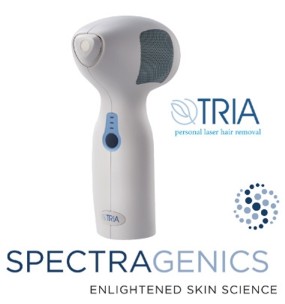SpectraGenics Gets Green Light For At-Home Laser Hair Removal
SpectraGenics Gets Green Light For At-Home Laser Hair Removal
Five years of research, clinical testing, and product design came to fruition last month when SpectraGenics received over-the-counter clearance from the Food and Drug Administration for TRIA, its patented, hand-held laser hair removal device designed for at-home use.
Diode lasers have been used for hair removal in the professional medical office setting for a decade or more. Now, the TRIA offers "an easy, safe way to obtain professional hair removal results in the privacy of one's home, replacing the time-consuming and often messy alternatives of daily shaving, waxing, or electrolysis," says the company.
The at-home device market is relatively new - and expected to grow exponentially over the next three years. The total hair removal industry, including professional laser treatments and waxing, represents $10 billion in consumer spending, SpectraGenics notes, citing data from the American Society for Aesthetic Plastic Surgery that "professional laser hair removal is consistently the leading non-surgical cosmetic treatment for women 34 years and under." In women over 35, Botox treatments top the list, with professional laser hair removal the second most popular procedure. Laser hair removal is also gaining broader acceptance among men.
Equipped with several safety mechanisms to reduce eye hazards commonly associated with laser devices, the TRIA diode laser reacts with the dark pigment of the hair shaft to target hair growth at the root for effective results. This reaction does mean that TRIA will not be effective for everyone, varying with both an individual's skin and hair color, the company points out. However, "on individuals with white to light brown skin, TRIA can safely be used on ... the nape of the neck, underarms, bikini line, legs, back, chest, abdomen, shoulders, feet, hands, and, for women only, upper lips and chins."
Because of the phases involved in hair growth - it takes approximately 33 weeks to complete an entire growth cycle - removal results do not appear immediately. Hair follicles that have been disabled must "eject" the hair from the skin, a process that usually takes two to three weeks. Since all hairs are not simultaneously in the "active" growth phase, when they are most susceptible to the treatment, multiple sessions are usually needed before visible results can be seen. However, a clinical study reports that users saw a 70 percent reduction in the amount of hair after three treatments. Hair that did grow back was perceived to be finer and lighter, the study observes.
SpectraGenics has been selling a version of the TRIA, called i-Epi, in Japan since 2005. The device can also be purchased in the European Union and will be available in the U.S. this spring. More information, including a deeper explanation of the scientific principles and clinical study data, can be found at www.triabeauty.com.
Also in this issue...
- Roche Molecular Diagnostics Opens New Research Building
- Pivot Interiors Finds a New Home in Hacienda
- Business Bits
- Executive Profile: Bob Baker, SynchroNet Marine CEO Sets Steady Course
- Credit Union Serves Alameda, Contra Costa Counties
- SpectraGenics Gets Green Light For At-Home Laser Hair Removal
- Life-Long Learners Find Abundant Opportunity in Local Continuing Ed Programs
- Livermore's Wine Country Beckons
- Star-Gazing in Livermore - at Upcoming 10th Annual California Independent Film Festival
- April 26 Food Drive is Student-Run Community Service Project
- Hacienda Index
- Calendar





